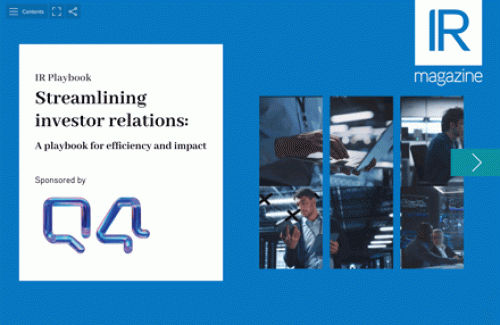No one in IR sets out to alienate or insult shareholders. But that’s what can happen when investor communications fall short of accessibility standards and companies compound the problem in their dealings with shareholders who have disabilities.
Jill Houghton, president and CEO of Disability:IN, tells of one case that illustrates how quickly a lack of awareness can damage or terminate an investor relationship. It began with what should have been a straightforward accessibility request by a shareholder with a hearing impairment. The company, unable to comply, suggested the shareholder – a corporate executive – use her guardian as a conduit for access. With that, the shareholder decided to reinvest her money elsewhere.
‘One billion people globally live with disabilities and have $8 tn in disposable income,’ Houghton says. ‘Like others, they invest some of that money. Companies are remiss if their investor relations program does not reflect this reality, but they must keep in mind we are not just talking about accessibility. It is equally important to treat this valuable category of investors as just that and not infantilize their abilities, acumen or financial worth.’
Old money, new needs
The demand for online accessibility increased during the Covid-19 pandemic as investor interactions became increasingly virtual. While many IR teams are relishing the prospect of returning to in-person events and interactions, the demand for accessibility both online and in real life is unlikely to decrease, particularly as shareholders age.
The Federal Reserve estimates that as of Q4 2020, baby boomers held collective wealth of $64.72 tn; GenXers bring another $33.06 tn to the table. At the same time, the Centers for Disease Control and Prevention reported in August 2020: ‘Generally, baby boomers have more chronic disease and disability than those in the previous generation.’
From an IR perspective, that means a sizable cohort of investors will be aging into living – and investing – with disabilities that will increase the existing demand for accessibility. And while technology offers many tools that can be part of the solution, experts say it’s equally important to cultivate an accessibility mindset.
The technology component
An accessible website, for example, is ‘coded in a way that assistive technology and accessibility features can use,’ says Jonathan Avila, chief accessibility officer at Level Access. ‘People who rely on the technology will almost always bring their own technology to the site, and it will work with their existing technology.’
He notes that best practice is to build accessibility into the initial website design. But given that most companies have existing websites that may fall short of that mark, the next best option is to audit the site with regard to ‘functional use-cases’ that assess whether a person with a disability can perform a particular task on the site. ‘Most people think they’re more accessible than they are,’ Avila says.
He and Houghton both stress the role procurement plays in ensuring compliance with current and future accessibility demands. They urge companies to demo and test purchases of new systems, software, apps or other products for built-in accessibility.
The human element
But technology is not a plug-and-play accessibility solution. The company and its IR representatives must also demonstrate an institutional and personal commitment to diversity, equity and inclusion. The company must make a point of stating that it is prepared to meet requests for accommodations at IR events or accessibility in IR materials.
Those who are best at this think ahead to unstated needs. Houghton offers the example of an investor event that will be attended by a shareholder with a service dog. The company should not only make sure there’s comfortable seating for the shareholder and the dog, but also speak with the hotel or meeting facility to identify the outdoor space provided for the animal to relieve itself. Attention to these small but essential details sets apart the IR teams that have really embraced inclusion.
It’s a lot to think about, and it’s easy to miss opportunities to maintain that standard. One strategy for cultivating a culture that’s more attuned to accessibility needs is to make inclusivity a priority in hiring, Houghton says. Her organization partnered with Accenture and the American Association of People with Disabilities on a study that culminated in the publication of Enabling Change: Getting to Equal 2020. As the Disability:IN website notes: ‘The research found that leading companies for disability employment and inclusion had, on average over a four-year period, 28 percent higher revenue, double the net income and 30 percent higher economic profit margins than other companies in the Disability Equality Index.’
Advocates note that the question is not if, but rather when, most people will develop a disability, whether permanent, temporary or situational. Statistically speaking, advancing age correlates to increasing disability: impaired vision, hearing, mobility or other challenges. ‘Providing multiple ways of engaging, interacting, communicating and providing feedback will help,’ Avila says. ‘You’re going to have a stronger ability to meet the needs of folks who need personalization, who need things in different formats, if you offer them in multiple ways.’
Building your IR accessibility toolkit
These resources provide additional background and a starting point for developing more accessible investor communications:
– Level Access, in collaboration with G3ict and IAAP, published the 2021 State of Digital Accessibility Report, which is available for download here
– Level Access also offers a free assessment of your website’s accessibility and provides a report on ‘your most at-risk areas and common issues’.
Another resource is The World Wide Web Consortium. Shawn Henry, who leads worldwide education and outreach activities promoting web accessibility for people with disabilities at the W3C Web Accessibility Initiative, cautions: ‘Digital accessibility is best not approached as a checklist. It is more complex than that. Instead, it is best approached by first understanding the user experience of people with disabilities, and then using the standards to help meet accessibility needs.’
With that caveat, she recommends the following resources:










